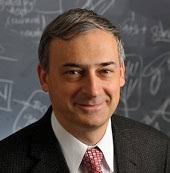In December’s blog post, we feature an interview with Dr. Mark Alber, Distinguished Professor of Mathematics and Director of the Interdisciplinary Center for Quantitative Modeling in Biology, University of California, Riverside.

When did you first become interested in mathematics and biology?
My father was a mathematician and my mother was a medical doctor, and initially I thought that their fields were very interesting but very different. I studied mathematics and physics in high school and college and got interested in applications of mathematics and physics to biology in 2000 after I was approached by biophysicists to discuss the role of reaction-diffusion equations in modelling chicken limb development.
Was the decision to do a Ph.D. an obvious and easy choice?
The decision to do a Ph.D. in “theoretical” applied mathematics (with proofs!) was neither obvious nor an easy choice. I first received a Masters Degree in Applied Mathematics with a focus on developing algorithms for image and pattern analysis and thought about going into industry.
How did you come to run your own group?
I was invited to be a Co-PI on an extended NSF-funded biocomplexity project and learned how interdisciplinary collaborations were run, including participation in regular group meetings.
What are your main research questions and why are they interesting?
How an organ’s shape and size emerges from cellular processes is an outstanding question of developmental biology. Force generation and material properties of cells must be carefully regulated as the organ grows to reach a final size. To test mechanistic scenarios, our group developed a detailed subcellular element multiscale mathematical model of a multilayered growing epithelial vesicle that incorporates cell growth, proliferation and local patterning of cellular mechanical properties that are downstream of morphogen signaling.
Our group is also working on a combined modeling and experimental study of the mechanisms of stem cell growth patterns in Arabidopsis shoot apical meristems (SAMs). In particular, we developed a biologically calibrated mathematical model to quantify the dual role of CLV3-signaling in inhibiting transcription of WUS and its synthesis and post-translational regulation offsetting the nuclear export of the WUS protein. Model sensitivity analysis and perturbation study were used to show that the dual control by the same signal formed a seamless connection between de novo WUSCHEL synthesis and sub-cellular partitioning in providing robustness to the WUSCHEL gradient, which can provide a general mechanism in other biological systems.
What makes you passionate about your work?
I am passionate about the opportunity of having an impact on both mathematics and biology as well as about reaching out to and closely collaborating with experimentalists. I also feel very strongly about promoting diversity, equity, and inclusion.
What is a typical work day/week like?
Very busy! I usually have 4-5 Zoom meetings to discuss progress on different projects per day every day of the week. In addition, I also regularly meet one-on-one with grad students and postdoctoral associates.
Do you have any advice for someone considering a career in mathematical biology?
I would like to encourage students to get trained in a variety of mathematical and computational modelling approaches, as well as data analysis and image analysis tools and get exposure to real experiments in a lab.
What do you like to do in your spare time outside of work?
Hiking with my family in Southern California.
Any final comments or advice?
I think that the field of mathematical, theoretical, and computational biology is at a very important stage when it can impact in very profound ways future development of both mathematics and biology.